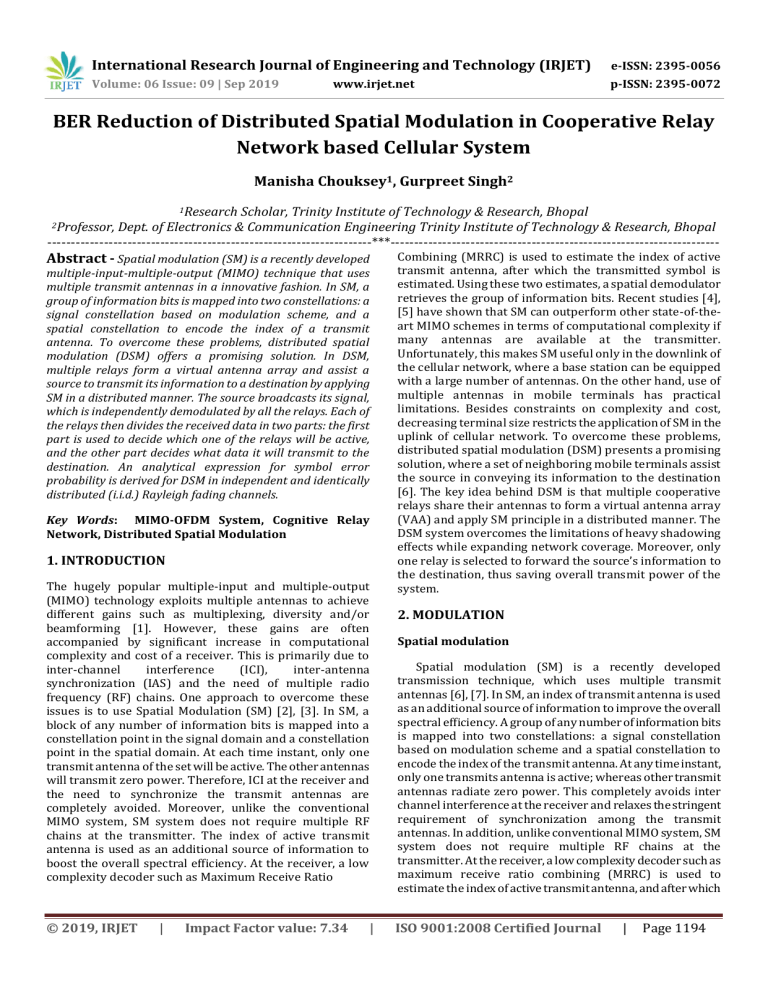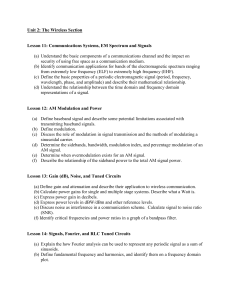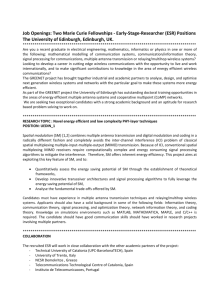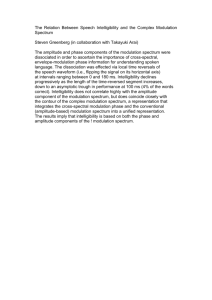IRJET-BER Reduction of Distributed Spatial Modulation in Cooperative Relay Network based Cellular System
advertisement

International Research Journal of Engineering and Technology (IRJET) e-ISSN: 2395-0056 Volume: 06 Issue: 09 | Sep 2019 p-ISSN: 2395-0072 www.irjet.net BER Reduction of Distributed Spatial Modulation in Cooperative Relay Network based Cellular System Manisha Chouksey1, Gurpreet Singh2 1Research Scholar, Trinity Institute of Technology & Research, Bhopal Dept. of Electronics & Communication Engineering Trinity Institute of Technology & Research, Bhopal ---------------------------------------------------------------------***---------------------------------------------------------------------2Professor, Abstract - Spatial modulation (SM) is a recently developed multiple-input-multiple-output (MIMO) technique that uses multiple transmit antennas in a innovative fashion. In SM, a group of information bits is mapped into two constellations: a signal constellation based on modulation scheme, and a spatial constellation to encode the index of a transmit antenna. To overcome these problems, distributed spatial modulation (DSM) offers a promising solution. In DSM, multiple relays form a virtual antenna array and assist a source to transmit its information to a destination by applying SM in a distributed manner. The source broadcasts its signal, which is independently demodulated by all the relays. Each of the relays then divides the received data in two parts: the first part is used to decide which one of the relays will be active, and the other part decides what data it will transmit to the destination. An analytical expression for symbol error probability is derived for DSM in independent and identically distributed (i.i.d.) Rayleigh fading channels. Key Words: MIMO-OFDM System, Cognitive Relay Network, Distributed Spatial Modulation 1. INTRODUCTION The hugely popular multiple-input and multiple-output (MIMO) technology exploits multiple antennas to achieve different gains such as multiplexing, diversity and/or beamforming [1]. However, these gains are often accompanied by significant increase in computational complexity and cost of a receiver. This is primarily due to inter-channel interference (ICI), inter-antenna synchronization (IAS) and the need of multiple radio frequency (RF) chains. One approach to overcome these issues is to use Spatial Modulation (SM) [2], [3]. In SM, a block of any number of information bits is mapped into a constellation point in the signal domain and a constellation point in the spatial domain. At each time instant, only one transmit antenna of the set will be active. The other antennas will transmit zero power. Therefore, ICI at the receiver and the need to synchronize the transmit antennas are completely avoided. Moreover, unlike the conventional MIMO system, SM system does not require multiple RF chains at the transmitter. The index of active transmit antenna is used as an additional source of information to boost the overall spectral efficiency. At the receiver, a low complexity decoder such as Maximum Receive Ratio © 2019, IRJET | Impact Factor value: 7.34 | Combining (MRRC) is used to estimate the index of active transmit antenna, after which the transmitted symbol is estimated. Using these two estimates, a spatial demodulator retrieves the group of information bits. Recent studies [4], [5] have shown that SM can outperform other state-of-theart MIMO schemes in terms of computational complexity if many antennas are available at the transmitter. Unfortunately, this makes SM useful only in the downlink of the cellular network, where a base station can be equipped with a large number of antennas. On the other hand, use of multiple antennas in mobile terminals has practical limitations. Besides constraints on complexity and cost, decreasing terminal size restricts the application of SM in the uplink of cellular network. To overcome these problems, distributed spatial modulation (DSM) presents a promising solution, where a set of neighboring mobile terminals assist the source in conveying its information to the destination [6]. The key idea behind DSM is that multiple cooperative relays share their antennas to form a virtual antenna array (VAA) and apply SM principle in a distributed manner. The DSM system overcomes the limitations of heavy shadowing effects while expanding network coverage. Moreover, only one relay is selected to forward the source’s information to the destination, thus saving overall transmit power of the system. 2. MODULATION Spatial modulation Spatial modulation (SM) is a recently developed transmission technique, which uses multiple transmit antennas [6], [7]. In SM, an index of transmit antenna is used as an additional source of information to improve the overall spectral efficiency. A group of any number of information bits is mapped into two constellations: a signal constellation based on modulation scheme and a spatial constellation to encode the index of the transmit antenna. At any time instant, only one transmits antenna is active; whereas other transmit antennas radiate zero power. This completely avoids inter channel interference at the receiver and relaxes the stringent requirement of synchronization among the transmit antennas. In addition, unlike conventional MIMO system, SM system does not require multiple RF chains at the transmitter. At the receiver, a low complexity decoder such as maximum receive ratio combining (MRRC) is used to estimate the index of active transmit antenna, and after which ISO 9001:2008 Certified Journal | Page 1194 International Research Journal of Engineering and Technology (IRJET) e-ISSN: 2395-0056 Volume: 06 Issue: 09 | Sep 2019 p-ISSN: 2395-0072 www.irjet.net transmitted symbol is estimated. Using these two estimates, a spatial demodulator retrieves the group of information bits. Distributed Spatial Modulation Spatial modulation (SM) is a new transmission technique for low-complexity implementation ofMIMO systems. In SM, the index of the active transmit antenna is employed as an additional means of conveying information. Since, only one transmit antenna is active at any time instant, inter-channel interference (ICI) and inter-antenna synchronization (IAS) are efficiently avoided. Recent studies [4]-[5] have shown that SM can outperform other state-of-the-art MIMO schemes in terms of computational complexity if many antennas are available at the transmitter. Unfortunately, this makes SM useful only in the downlink of the cellular network, where a base station can be equipped with a large number of antennas. On the other hand, use of multiple antennas in mobile terminals has practical limitations. 3. COGNITIVE RADIO With proliferation in smartphone devices and a growing interest in multimedia applications, there is unprecedented growth in mobile data traffic resulting in problem of spectrum scarcity. Most suitable frequency bands (below 3GHz) have already been assigned under the licensed bands for the existing wireless systems, which increases the complexity and difficulty to find available frequency bands for new wireless systems. Furthermore, current spectrum allocation policy is inflexible to allow sharing of the licensed bands, although several field measurements performed from leading spectrum regulatory commissions, such as the Federal Communications Commission (FCC) in the United States [8] verified that there are licensed bands unoccupied most of time or partially occupied. Fig -1: Concept of opportunistic spectrum sharing: secondary utilization of the identified spectrum holes. Therefore, there are spectrum holes or white bands in certain time, frequency, and positions as shown in Fig. 1, which result in reducing the spectrum efficiency. These challenging problems of spectrum inefficiency motivated researchers to find efficient solutions which result in the concept of cognitive radio. It is a new communication paradigm that can effectively exploit the existence of spectrum holes by enabling unlicensed users to intelligently © 2019, IRJET | Impact Factor value: 7.34 | utilize these spectrum holes without causing harmful interference to the licensed users (primary users). Originally, the concept of cognitive radio is to sense the spectrum in order to find the unoccupied bands and then utilize them wisely at a certain time [9]. This concept has recently been developed to be fully aware of the surrounding environment and the primary users, and thereby further improve the efficiency of spectrum utilization. 4. PROPOSED METHODOLOGY Consider Nt × Nr DSM-MIMO system for point-to-point communications. Nt is the transmitter antenna and Nr is the receiver antenna. The basic concept of SM is to map the information bits into two constellations: the spatial constellation and the signal constellation. The bit stream is divided into blocks of ns bits, where ns are the number of bits per symbol. Each block is then split into two parts of log2Ntand log2 M bits, where M denotes the size of the signal constellation diagram. The first part activates one of the N t transmit antennas, and we denote the currently active antenna as l. The second part selects one symbol from the signal constellation diagram, and the active antenna conveys this symbol, which is denoted by s. The whole transmission occurs in two phases and lasts for two time slots 1) broadcasting phase (first time slot) in which the source broadcasts its information to all the relays. The source applies incoming binary data to OFDM modulator and broadcasts the resulting OFDM signal over multipath Rayleigh fading channels between the sources and relays. Each of the relays independently demodulates the received OFDM signal using OFDM demodulator 2) relaying phase (second time slot) in which relays use DSM-OFDM protocol (described in the next section) to forward the sources information to the destination. The source remains silent during this phase to avoid collisions with data transmitted from relays to the destination. Using DSM-OFDM protocol, each relay encodes demodulated binary data such that in each OFDM subcarrier, only one relay transmits the data, while other relays radiate zero power. The number of subcarriers required to transmit the source’s information depends on the number of available relays and modulation schemes used both at the source and relays. It is possible that all the subcarriers are not required to forward the source’s information. Therefore, the remaining subcarriers can be utilized by the relays to transmit their own information. In DSM, the number of activated relays during the relaying phase depends on the demodulation outcome at the relays. In other words, the larger the number of activated relay is, the higher the energy consumption is. This is in stark contrast compared to conventional relaying protocols, where the set of activated relays is fixed and the net effect of an incorrect demodulation at the relays results only in forwarding erroneous data to the destination. In DSM, on the ISO 9001:2008 Certified Journal | Page 1195 International Research Journal of Engineering and Technology (IRJET) e-ISSN: 2395-0056 Volume: 06 Issue: 09 | Sep 2019 p-ISSN: 2395-0072 www.irjet.net other hand, the activation of multiple relays may lead to an increase of the energy consumption. The objective of this section is to show that the average (i.e., with respect to all possible activation patterns of the relays) energy consumption of DSM in the presence of demodulation errors at the relays is the same as the energy consumption of DSM in the absence of demodulation errors at the relays, i.e., ES + ER. Interleaving is the third most important concept applied. The radio channel may affect the data symbols transmitted on one or several sub carriers which lead to bit errors. To encounter this issue we use efficient coding schemes [8]. 5. SIMULATION RESULTS In this section, the bit error ratio (BER) performance of DSMMIMO-OFDM scheme is evaluated using Monte Carlo simulations. It is assumed that channel state information (CSI) is available at the destination and all the relays. For a fair comparison, the total transmission power in each subcarrier is set to 1W for all the schemes and it is equally divided between the broadcasting and relaying phase. Perfect frequency and time synchronization is assumed. Fig -2: Block Diagram of Proposed Model This result is important for guaranteeing a fair comparison with conventional relaying protocols and for ensuring that the power consumption does not increase in the presence of unreliable source-to-relay links. OFDM is a special form of multicarrier modulation (MCM) with densely spaced subcarriers with overlapping spectra, thus allowing multiple-access. MCM works on the principle of transmitting data by dividing the stream into several bit streams, each of which has a much lower bit rate, and by using these sub-streams to modulate several carriers. This technique is being investigated as the next generation transmission scheme for mobile wireless communications networks. Fig -3: Total Error Rate v/s Threshold for Different System Simulation experiments are conducted to evaluate the total error rate VS threshold performance of the proposed cooperative distributed spatial modulation is shown in figure 3. OFDM structure basically relies on three principles: The IFFT and FFT are used for modulating and demodulating individual OFDM sub carriers to transform the signal spectrum to the time domain for transmission over the channel and then by employing FFT on the receiving end to recover data symbols in serial order. The second key principle is the cyclic prefix (CP) as Guard Interval (GI). CP keeps the transmitted signal periodic. One of the reasons to apply CP is to avoid inter-carrier interference (ICI). © 2019, IRJET | Impact Factor value: 7.34 | Fig -4: BER v/s SNR for Different System ISO 9001:2008 Certified Journal | Page 1196 International Research Journal of Engineering and Technology (IRJET) e-ISSN: 2395-0056 Volume: 06 Issue: 09 | Sep 2019 p-ISSN: 2395-0072 www.irjet.net Simulation experiments are conducted to evaluate the SNR VS Bit Error Rate (BER) performance of the proposed cooperative distributed spatial modulation is shown in figure 4. frequency allocation for the relays is modeled through a weighted bipartite graph and the optimal frequency allocation for the relays is formulated as minimum weight perfect matching problem. Simulation results are provided to verify the improvement in the SER performance of DSM using the proposed frequency allocation schemes. The proposed MIMO-OFDM system using cooperative distributed spatial modulation give a lower BER 0.00002 dB as compared with 0.00003 dB for SNR = 20 dB, previous MIMO-OFDM system using cooperative distributed spatial modulation. The proposed method is 33.33% BER improvement for previous method. REFERENCES [1] Shan Jin and Xi Zhang, “Compressive Spectrum Ali Afana, Telex M. N. Ngatched, Octavia A. Dobre, and SalamaIkki, “Cooperative DF Cognitive Radio Networks with Spatial Modulation with Channel Estimation Errors” 978-15090-4183-1/17/$31.00 ©2017 IEEE. [2] KunalSankhe, SachinChaudhari, and Garimella Ramamurthy, “Distributed Spatial Modulation in Cognitive Relay Network”, submitted in IEEE Transactions on Cognitive Communications and Networking, May 2016. [3] Aparna Singh Kushwah and Alok Kumar, “Study of Distributed Spatial Modulation in Cognitive Relay Network based MIMOOFDM System”, International Journal of Innovative Research in Science, Engineering and Technology, Vol. 07, Issue 04, April 2018. [4] KunalSankhe, and Garimella Ramamurthy, “Distributed Spatial Modulation-OFDM in Uplink Relay-assisted Cellular Network,” accepted in Wireless Personal Multimedia Communications (WPMC) 2015. [5] KunalSankhe, Chandan Pradhan, Sumit Kumar, and Garimella Ramamurthy, “Machine Learning Based Cooperative Relay Selection in Virtual MIMO”, in Wireless Telecommunications Symposium (WTS) 2015, New York, USA, Jun. 2015. [6] Aparna Singh KushwahandNileshLonare, “Performance Analysis of Spectrum Sensing MIMO-OFDM based Cognitive Radio”, International Journal of Innovative Research in Computer and Communication Engineering, Vol. 5, Issue 09, September 2017. [7] Chandan Pradhan, KunalSankhe, Sumit Kumar, and Garimella Ramamurthy, “Full-Duplex eNodeB and UE Design for 5G Networks”, in Wireless Telecommunications Symposium (WTS) 2015, New York, USA, Jun. 2015. [8] Chandan Pradhan, KunalSankhe, Sumit Kumar, and Garimella Ramamurthy, “Revamp of eNodeB for 5G Fig -5: Comparative Result Simulation experiments are conducted to evaluate the SNR VS BER performance of the proposed cooperative distributed spatial modulation and spatial modulation is shown in figure 5. Table -1: Comparative Result of BER BER SNR (dB) 0 5 10 15 20 Previous Algorithm 10-1 8×10-3 8×10- 10-4 3×10-5 Proposed Algorithm 8×10- 4×10- 7×10- 2×10-5 4 5 4 5×10-3 2 Table 1 the tabular illustration of the performance of different SNR discussed in this research work in term of Bit Error Rate (BER). From the analysis of the results, it is found that the proposed cooperative distributed spatial modulation gives a superior performance as compared with the previous method. 6. CONCLUSIONS The implementation of DSM is extended to cognitive network scenario. A dynamic frequency allocation scheme is proposed for the source and relays separately to allocate idle licensed frequencies. The frequency allocation for the source is formulated as unconstrained optimization problem with an objective to maximize the probability of correct estimation of transmitted symbols at all the relays. The © 2019, IRJET | Impact Factor value: 7.34 | ISO 9001:2008 Certified Journal | Page 1197 International Research Journal of Engineering and Technology (IRJET) e-ISSN: 2395-0056 Volume: 06 Issue: 09 | Sep 2019 p-ISSN: 2395-0072 www.irjet.net Networks: Detracting Spectrum Scarcity”, in Consumer Communications and Networking Conference (CCNC) 2015, 12th Annual IEEE, pp. 862-868, Jan. 2015. [9] DeeptiSinghal, Chandan Pradhan, KunalSankhe, Garimella Ramamurthy, “Cognitive Radio Networks: Issues and Solutions,” in Handbook of Research on SelfOrganized Mobile Communication Technologies, IGI Global 2015. [10] Sankhe, Chandan Pradhan, Sumit Kumar, and Garimella Ramamurthy, “Cost effective restoration of wireless connectivity in disaster hit areas using Open BTS,” in India Conference (INDICON), 2014 Annual IEEE, pp. 1-6, Dec. 2014. [11] Chandan Pradhan, KunalSankhe, Sumit Kumar, and Garimella Ramamurthy, “Cognitive base station design for efficient spectrum utilization in cellular network,” in Wireless and Optical Communications Networks (WOCN) 2014, pp. 1-7, Sep. 2014. [12] Q. Wu, W. Chen and M. Tao, “Resource allocation for joint transmitter and receiver energy efficiency maximization in downlink OFDMA systems,” IEEE Trans. Communication, vol. 63, no. 2, pp. 416-430, Feb. 2015. [13] J. B. Rao and A. O. Fapojuwo, “Analysis of spectrum efficiency and energy efficiency of heterogeneous wireless networks with intra-/inter- RAT offloading”, IEEE Trans. Veh. Technol., vol.64, no. 7, pp. 3120- 3139, Jul. 2015. [14] K. Davaslioglu, C. C. Coskan and E. Ayanoglu “Energyefficient resource allocation for fractional frequency reuse in heterogeneous networks,” IEEE Trans. Wireless Communication, vol. 14, no. 10, pp. 5484- 5497, Oct. 2015. © 2019, IRJET | Impact Factor value: 7.34 | ISO 9001:2008 Certified Journal | Page 1198




